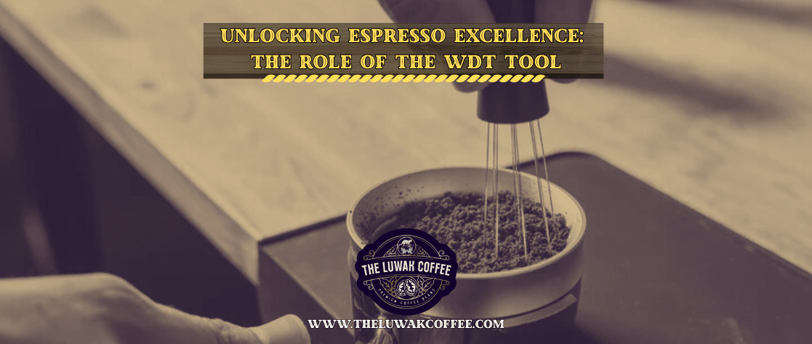CERTIFIED WILD LUWAK COFFEE, 100% WILD
Unlocking Espresso Excellence: The Role of the WDT Tool
ESPRESSO-RELATED
2/21/20257 min read


Introduction to WDT: What Is It?
The Weiss Distribution Technique (WDT) is a method developed to enhance the distribution of coffee grounds within an espresso portafilter before extraction. This tool has its origins in the espresso community, as baristas and coffee enthusiasts sought to address uneven distribution, which often leads to channeling—when water passes through the coffee puck unevenly, resulting in inconsistent extraction and undesirable flavors. The WDT aims to solve this problem by ensuring an even distribution of coffee particles.
At its core, the WDT involves the use of a specialized tool, typically consisting of a cluster of thin, sharp needles or a fine-tipped whisk, which is employed to gently agitate the coffee grounds within the portafilter. This gentle stirring action breaks up clumps and redistributes the coffee particles more uniformly. By ensuring that the coffee grounds are evenly distributed, espresso brewers can optimize the flow of water through the puck, which helps achieve a more consistent and balanced espresso extraction.
The importance of the WDT tool cannot be overstated when it comes to espresso brewing. Achieving a well-extracted shot depends significantly on the uniformity of the coffee grounds, as variations in particle size and distribution can lead to uneven contact with water, affecting the taste and quality of the final brew. Many professional and home baristas have adopted the WDT as an essential part of their espresso preparation process. The tool not only contributes to improved flavor complexity but also elevates the overall quality of the extraction. Therefore, understanding the WDT tool and its application is crucial for anyone looking to unlock the full potential of espresso brewing.
The Science of Espresso Extraction
Espresso extraction is a delicate balance of physics and chemistry that determines the quality of the final cup. At the core of this process lies the interaction between water and coffee grounds. When hot water is forced through finely ground coffee, it dissolves soluble compounds, resulting in a rich and flavorful brew. However, the intricate dynamics of this extraction can lead to potential pitfalls, particularly channeling and uneven coffee distribution.
Channeling occurs when water flows unevenly through the coffee puck, leading to an inefficient extraction. This phenomenon can result from unevenly distributed coffee or variations in grind size. When water finds a path of least resistance, it tends to bypass some areas entirely, leaving those portions under-extracted and others over-extracted. The consequence of such inconsistencies manifests in the espresso's flavor profile, often yielding undesirable bitterness or sour notes. The result is a cup that lacks the desired balance, showcasing the significance of effective coffee distribution.
Even coffee distribution plays a critical role in espresso extraction. A uniform puck ensures that water interacts evenly with the coffee grounds, promoting a consistent extraction across the entire surface area. Uneven distribution can create voids in the puck, where water flows rapidly, exacerbating the channeling effect and leading to variability in the brewing result. This inconsistency can particularly impact taste, aroma, and body of the espresso, highlighting why meticulous attention to the distribution process is paramount.
The use of the WDT (Weiss Distribution Technique) tool can significantly mitigate these challenges. By providing a method to break up clumps and distribute grounds evenly, the WDT tool assists baristas and coffee enthusiasts alike in achieving optimal extraction. Understanding the scientific principles behind espresso extraction empowers coffee aficionados to refine their brewing techniques and appreciate the intricate nuances of this beloved beverage.
Understanding the Mechanics of the WDT Tool
The Weiss Distribution Technique (WDT) tool plays a crucial role in achieving optimal espresso extraction by addressing the common issue of uneven coffee distribution. When coffee beans are ground, they can form clumps due to static electricity or the inherent structure of the grounds. These clumps can hinder water flow during brewing, resulting in under-extraction and a less flavorful espresso. The WDT tool facilitates the disintegration of these clumps, ensuring that ground coffee is evenly distributed within the portafilter.
Utilizing a series of slender, pointed prongs, the WDT tool systematically stirs the coffee grounds, breaking apart any aggregations. This process promotes a more consistent grain size and ensures that each particle is adequately exposed to water during extraction. As a result, the individual coffee particles contribute more evenly to the flavor profile, providing a more balanced and satisfying cup of espresso.
In terms of design, there are various WDT tools available in the market, catering to different preferences and needs. Some models feature solid handles combined with stainless steel prongs, offering durability and ease of use. Others may incorporate adjustable prong lengths, enabling users to customize their approach based on the coffee type or grind size. Additionally, there exist compact, travel-friendly designs that make it convenient for espresso enthusiasts on the go.
Regardless of the specific design, the fundamental principle remains the same: the WDT tool's primary function is to promote even ground distribution, leading to a uniform puck that enhances the brewing process. By investing in a WDT tool, espresso lovers can significantly improve their extraction quality and unlock a more profound appreciation for their favorite beverage.
Benefits of Using the WDT Tool
The use of the Weiss Distribution Technique (WDT) tool in espresso preparation offers various advantages that significantly enhance the brewing process. One of the primary benefits is the improvement in extraction efficiency. By utilizing the WDT tool, baristas can effectively distribute coffee grounds in the portafilter, preventing clumping. This even distribution allows for a more uniform extraction, which is essential for achieving a balanced flavor profile in espresso. When coffee grounds are distributed evenly, water flows through them more uniformly, resulting in a smoother and more harmonious taste.
Another notable advantage is the enhancement of flavor consistency across shots. Consistency is crucial for coffee professionals seeking to deliver the same quality experience to customers with every cup. The WDT tool aids in minimizing channeling, which is a common occurrence when water passes through unevenly packed coffee grounds. By reducing channeling, the WDT tool helps ensure that every shot pulled maintains the same flavor characteristics, making it easier for baristas to replicate their desired outcomes. This aspect has garnered positive feedback from seasoned baristas, who report more predictable espresso quality.
Furthermore, incorporating the WDT tool positively impacts the crema of the espresso. Crema is an essential aspect of espresso quality, as it adds to the overall aesthetic and perceived richness of the coffee. With improved extraction efficiency and reduced channeling facilitated by the WDT tool, the result is a thicker, richer crema that enhances both flavor and presentation. Real-life testimonials from experienced baristas highlight their satisfaction with the WDT’s ability to produce superior cremas, showcasing how this tool can elevate the espresso experience.
Step-by-Step Guide to Using the WDT Tool
The use of the Weiss Distribution Technique (WDT) tool can significantly enhance the consistency and quality of your espresso shots. To effectively incorporate this tool into your espresso-making routine, follow these detailed steps.
Firstly, gather all necessary equipment, including your espresso grinder, WDT tool, portafilter, and freshly roasted coffee beans. Begin by calibrating your grinder to achieve an appropriate grind size. A finer grind is often suitable for espresso, but the specific grind profile may vary depending on the beans used.
Once the beans are ground, transfer the coffee grounds into the portafilter. It is advisable to do this gently to avoid creating clumps. An even coffee bed is crucial for optimal extraction. Next, take the WDT tool, which typically features a series of thin needles or wires attached to a handle, and gently insert the needles into the coffee grounds. Use a circular motion to disperse the coffee evenly, breaking up any clumps and ensuring uniformity. This process helps to prevent channeling during the extraction phase.
As a best practice, aim to perform the WDT technique for approximately 10 to 15 seconds, ensuring that all coffee grounds are adequately treated. After the WDT tool has been used, tap the portafilter lightly to settle the coffee bed before tamping it with consistent pressure. Ensure that the tamp is level to promote even extraction.
Lastly, a common mistake to avoid is applying excessive force with the WDT tool, which could compact the coffee grounds instead of distributing them evenly. Additionally, ensure that your tool is clean and well-maintained to achieve optimal results. Once you have completed these steps, you are ready to attach the portafilter to your espresso machine and begin the extraction process. This methodical approach with the WDT tool will lead to a remarkable improvement in your espresso shots.
Common Mistakes and Troubleshooting
While the WDT (Weiss Distribution Technique) tool can greatly enhance espresso preparation, users often encounter a few common mistakes that can hinder performance and detract from the quality of the brew. Understanding these pitfalls is essential to optimize the use of the WDT tool and achieve the best results. One frequent error is applying excessive force during the distribution process. This can compact the coffee grounds, leading to channeling and uneven extraction. It’s crucial to apply a gentle, controlled motion when using the WDT tool to maintain the integrity of the coffee bed.
Another common mistake involves neglecting the importance of consistent grinding size. If the grind size varies significantly, even the most careful distribution with the WDT tool may not rectify the issues related to extraction uniformity. Users should ensure they are employing a high-quality grinder and regularly calibrating it for optimal results. It is also beneficial to periodically check for clogs or malfunctions in the grinder, as these can lead to inconsistent grind sizes, affecting the effectiveness of the WDT tool.
When troubleshooting, users must pay attention to the espresso’s flow rate and overall flavor profile. If shots are extracting too quickly or slowly, this signals a need for adjustment in grinding or tamping techniques. To better refine the setup, conducting taste tests and taking notes can help identify patterns in flavor and extraction times. Additionally, malfunctioning or improperly calibrated WDT tools can lead to ineffective distribution. Regular maintenance and calibration of the WDT tool are essential steps to prevent potential issues and enhance the espresso-making experience. By recognizing these common mistakes and employing straightforward troubleshooting techniques, users can significantly improve their espresso outcomes.
Conclusion: Enhancing Your Espresso Game
Throughout this blog post, we have explored the pivotal role of the WDT (Weiss Distribution Technique) tool in achieving exceptional espresso shots. The WDT tool is a simple yet effective instrument that addresses common issues related to coffee distribution in the portafilter, ultimately leading to a more uniform extraction. By utilizing this technique, baristas and coffee enthusiasts can significantly improve their espresso game.
The advantages of implementing the WDT tool extend beyond just enhanced flavor; they also encompass a more consistent brewing experience. By breaking up clumps and ensuring an even distribution of coffee grounds, the WDT technique minimizes channeling and over-extraction, which can often lead to bitter or sour notes in the final cup. This simple tool thus becomes essential for anyone serious about espresso preparation, whether at home or in a professional setting.
Encouraging readers to incorporate the WDT tool into their brewing routine can open up new dimensions of flavor and consistency. It is not only a matter of following a trend; it represents a commitment to excellence that can transform the drinking experience. We invite you to experiment with your espresso preparation, adapting the WDT technique to suit your specific setup and taste preferences. As you embark on this journey, we would love to hear about your experiences. Share your results and modifications, and engage with other coffee lovers to collectively enhance your barista skills. Remember, the path to unlocking espresso excellence is every bit as rewarding as the final cup itself, and it starts with tools like the WDT.
